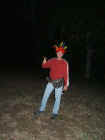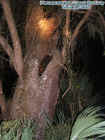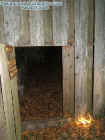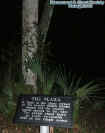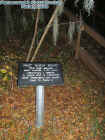|
|
||
|
About 14,500 BP the Crystal River area was about 250 lower in sea level and a 100 miles farther west then it is today. But about 5000 years later the area was a gathering place for Nomadic hunters and gatherers. Even at that time of 10,000 BP the Crystal River had not even begun to flow yet until a few thousand years later. When the river increased in size it resulted in a large increase in food supplies. Signs of this are a half of mile away at he mouth of the Crystal River as grass flats extend many miles into the gulf with oyster beds and abundant sea food. This caused a social structure and many small communities in the area when food became more abundant. This area became the longest occupied pre-Columbian sites in the State of Florida perhaps that is what makes it such a special ancient site. The Crystal River Site became the regional center for the Florida Gulf Coast Deptford people. The site would be a place they would travel for religious, political guidance, ceremonial gatherings and trading of goods. Its said yearly that 7,500 Native Americans would visit the site. The site had burial mounds, temple mounds, a very large shell Midden and a plaza. A shell Midden is composed of oyster shells, food stuffs, and house hold materials much like today we have land fills. The native Americans would discard there shells and put layers of dirt on top of them thus forming a mound. Mound construction did not begun till roughly 700BP to 500 BP and it would cover an area of roughly 1,300 feet which is the park today which we visited. The most prestigious mound of all is known as the Temple Mound which is a large shell heap and from the top you could see the gulf of Mexico. The mound is said to be 28 feet high, 107 feet in length, and 50 feet wide. The shell ramp for it was 80 feet long and 14 to 21 feet wide and extended into the shell causeway. The causeway led towards the burial area and a marker stone. The mound had a temple look because the top of it was flat not round so it was called the temple mound. C.B. Moore was one of the first to describe the mound in 1903. Sad to say in 1960 a previous landowner removed two thirds of the temple mound for fill. If you stand over the edge of the mound and look down there are signs that the mound has been severely eroded. That activity uncovered charcoal lenses on the north east side. Many pottery shards were found along with the lenses and when carbon dated it to approximately 600 A.D. during the Safety Harbor Period. Although other mounds were constructed before then. Today the shell ramp is gone and the mound is covered with very heavy vegetation. By 1,000 A.D. it was said there may have been up to 10,000 people living near the Crystal River Archaeological site so it was obvious as to why this mound was so large in size. More settlers meant more food and more heaps of oyster shells. Two of the oldest mounds here were uncovered by Ripley Bullen was the first to locate and map them in the 1960s which was the sites first archaeologist. They were called the priest mound and the village mound. This terminology was based on evidence of a ramp that was once on the eastern side of the Priests Mound. The earth ramp pointed to the northeast from the priest mound through the centered of the plaza to a similar ramp that is located at the far end of the plaza at the second temple mound. The second temple mound led to higher mounds to be constructed in the surrounding area. At one time the area was so overgrown with vegetation nobody knew of these mounds existence. The burial mound complex was not formed till roughly 250 B.C. all the way to 1,300 A.D. There are roughly 1000 to 1500 burials within these mounds. The first excavation of this mound complex did not take place till 1903 by a man with the name of Clarence B. Moore. Many of the burials in this mound were people that had exotic artifacts buried with them like copper objects, mica, lead, crystals from trades which took place from northern regions of North America maybe even tribes up in WNY for instance where today many Indian reservations still exist where tribes once roamed. Bullen who visited the site in the 1950s said two different cultural periods occurred during the sites occupation based on the pottery examinations. He contacted the Florida Park Service to acquire it as an archaeological site. He reburied at least 425 sets of skeletal remains which were removed from the mound by Moore. He also restored some of the mounds structures which were damaged by previous excavations. He would eventually develop interpretive exhibits for the sites visitors. In 1964 Moore began to clear the land and discovered two ceremonial stones known as Stelae pronounced Stele. One of those stele was located near the Main Burial Complex which was erected in 440 A.D. it has a crude outline of a man's face, shoulders, with flowing hair and an ear spool. Nobody knows what the stone served as some say they were used as celestial markers for some sort of seasonal calendar. Some theorize there are other stones in the area which still remain hidden if those can be found then perhaps it will unravel its secrets to what there purpose is. I was not able to find these stones must had missed them on our hike perhaps even they been moved into the museum area for preservation since they are made of limestone eventually the rain would erode them.. In 1990 the 6 mound complex was recognized as a National Historic Landmark and has been under protection now for 40 years by the Florida State Park Service. It serves as a reminder that at one time it was home to the Paleo people in Florida and home to Native Americans for over 2,000 years. Walking around the entire complex gives you a real eerie feeling. Although our first trip here did not produce many ghost photos there is a real feeling of never being alone here as movement is heard, strange scents, feelings of being watched, and heavy cold spot activity. The place still today has just as much mystery as it does history and now PGS brings it all to you! © By Rick-AngelOfThyNight
In accordance with Title 17 U.S.C. Section 107, any copyrighted work in this message is being distributed under fair use without profit or payment to those who have expressed a prior interest in receiving the included information for non-profit research and educational or criticism purposes only. Notwithstanding the provisions of sections 106 and 106A, the fair use of a copyrighted work, including such use by reproduction in copies or phone records or by any other means specified by that section, for purposes such as criticism, comment, news reporting, teaching (including multiple copies for classroom use), scholarship, or research, is not an infringement.
|
||
|
|
|









